Commentary
Video
Dr Pal on the Preliminary Efficacy of DFF332 in Advanced ccRCC
Author(s):
Sumanta Kumar Pal, MD, FASCO, discusses preliminary findings from a phase 1 dose-escalation study of DFF332 in patients with advanced ccRCC.
Sumanta Kumar Pal, MD, FASCO, chair, Kidney and Bladder Cancer Disease Team; co-director, Kidney Cancer Program; professor, vice chair, Academic Affairs, Department of Medical Oncology & Therapeutics Research, City of Hope, discusses preliminary findings from a phase 1 dose-escalation study (NCT04895748) evaluating the pharmacokinetics and clinical activity of DFF332 in patients with advanced clear cell renal cell carcinoma (ccRCC).
DFF332 is similar to agents such as belzutifan (Welireg) in that it is a HIF2a inhibitor, Pal says. In the phase 1 trial, this agent was administered orally either daily or weekly as part of a dose-escalation design in a relatively large cohort of 40 patients with metastatic ccRCC, Pal notes.
Preliminary results from the dose-escalation portion of the study revealed that patients who received DFF332 did not experience severe levels of hypoxia or anemia, which makes the safety profile of DFF332 relatively unique, Pal explains. Among the entire patient population, 62.5% of patients experienced at least 1 adverse effect (AE). The most common AEs observed in this population include anemia (12.5%), hypercholesterolemia (12.5%), fatigue (12.5%), increased alanine transaminase (10.0%), hypertriglyceridemia (10.0%), increased aspartate aminotransferase (7.5%), dizziness (7.5%), dyspnea (5.0%), hypertension (5.0%), increased lipase (5.0%), nausea (5.0%), and peripheral edema (5.0%).
Notably, the responses observed with the agent were not comparable to those historically seen with belzutifan in patients with ccRCC, Pal emphasizes, noting that this discrepancy may have been due to the heavily pretreated nature of the patients from the phase 1 trial. DFF332 elicited a 52.5% disease control rate, with best responses of partial response and stable disease in 5% and 47.5% of patients, respectively. The best percentage of change in tumor size from baseline per RECIST criteria was 87.5%. Furthermore, at the data cutoff, treatment was ongoing on 27.5% of patients. The median duration of treatment exposure was 17.9 weeks (range, 1.0-75.6).
Going forward, DFF332 may be investigated in combination with immune checkpoint inhibitors or other targeted agents, Pal concludes.


















%20(2)%201-Recovered-Recovered-Recovered-Recovered-Recovered-Recovered-Recovered-Recovered-Recovered-Recovered-Recovered-Recovered-Recovered-Recovered-Recovered-Recovered-Recovered.jpg?fit=crop&auto=format)
%20(2)%201-Recovered-Recovered-Recovered-Recovered-Recovered-Recovered-Recovered-Recovered-Recovered-Recovered-Recovered-Recovered-Recovered-Recovered-Recovered-Recovered-Recovered.jpg?fit=crop&auto=format)
